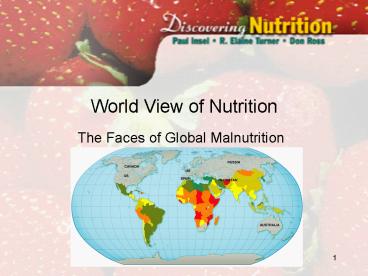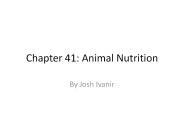World View of Nutrition - PowerPoint PPT Presentation
1 / 49
Title:
World View of Nutrition
Description:
Free and reduced price meals. Child and Adult Care Food Program. 11 ... Individualized meal plans. Food/grocery programs. Nutrition supplements ... – PowerPoint PPT presentation
Number of Views:156
Avg rating:3.0/5.0
Title: World View of Nutrition
1
World View of Nutrition
- The Faces of Global Malnutrition
2
Malnutrition (Chp. 15) Objectives
- Understand the prevalence and programs designed
to attack hunger in America - Become familiar with malnutrition in the
developing world and discuss its ramifications
socially, economically, and agriculturally. - Comprehend chronic types of worldwide malnutrition
3
Protein-Energy Malnutrition
- Acute PEM
- recent severe food deprivation
- Chronic PEM
- long-term food deprivation
- Classifying PEM
- marasmus
- kwashiorkor
- combination
4
Marasmus Kwashiorkor
- Infancy (lt 2 yrs)
- severe deprivation
- develops slowly
- severe weight loss
- severe muscle wasting
- low growth (lt60)
- no edema, no fatty liver
- anxiety, apathy
- possible good appetite
- hair thin,dry skin dry
- Older infants (1-3 y.o.)
- low protein, infections
- rapid onset
- some weight loss
- some muscle wasting
- growth 60-80
- edema enlarged fatty liver
- apathy, misery, irritable
- loss of appetite
- hair dry skin lesions
5
(No Transcript)
6
- Marasmus-Kwashiorkor Mix
- edema of kwashiorkor with wasting of marasmus
malnutrition and infections - Infections
- antibodies are degraded to provide a.a. for other
uses no synthesis of blood proteins thus weak
and anemic - dysentery infection of GI tract diarrhea
- Rehabilitation
- after first 24-48 hours protein and food energy
given in small quantities and gradually increased
7
Hunger
- Inability, day after day, to satisfy basic
nutrition needs, gnawing emptiness that creates a
constant focus on eating and how to obtain food - Access to food must be secure before obtaining a
nutritionally adequate diet and dealing with
health issues become a goal.
8
Malnutrition in the United States
- Food insecurity
- Anxiety about having enough to eat
- Worry about having no money to buy food
- Prevalence and distribution
- Strongly associated with poverty
- Linked with economic and social factors
9
Groups at risk hunger, malnutrition
- The working poor
- May or may not qualify for food assistance
- The isolated
- Lack access to food resources
- Elders Children
- Economic difficulties -Dependent of family
- Physical ailments -Hunger effects school
- The Homeless
- Lack consistent cooking facilities
- Limited income, if any
10
Attacking Hunger in America
- The Food Stamp program
- Extends food buying power
- Special Supplemental Nutrition Program for Women,
Infants, and Children (WIC) - Food, nutrition services for pregnant and
lactating women, and children to age 5 - National School Lunch Program
- Free and reduced price meals
- Child and Adult Care Food Program
11
Malnutrition in the Developing World
- Factors that contribute to hunger and
malnutrition - Social and economic factors
- Poverty
- Population growth
- Urbanization
- Infection and disease
12
(No Transcript)
13
Malnutrition in the Developing World
- Factors that contribute to hunger and
malnutrition - Political disruptions and natural disasters
- War
- Refugees
- Sanctions
- Floods, droughts, mudslides, hurricanes
- Inequitable food distribution
14
Malnutrition in the Developing World
- Agriculture and environment a tricky balance
- Environmental degradation
- Reduced food production
- Nutritional consequences
15
Malnutrition in the Developing World
- Common forms of malnutrition
- Vitamin A deficiency
- Leading cause of preventable blindness
- Iron-deficiency anemia
- Limits productive of population
- Other vitamin, mineral deficiencies
- Iodine deficiency disorders
- Most common cause of preventable brain damage
- Overweight and obesity
- Differing cultural attitudes
- High calorie, low nutrient dense foods
16
Malnutrition and AIDS
- Causes
- anorexia and inadequate intake
- malabsorption other GI disorders
- hypermetabolism
- food-drug interactions
- Wasting Syndrome
- 10 unintentional loss in body weight, with
diarrhea/weakness/fever more than 30 days - At 66 of IBW, death likely to occur
17
Lean Tissue Loss
- 10 low albumin, anemia, low immunity
- 15-25 reduced healing
- 30 non-healing skin ulcers
- 35 to weak to sit
- 40 to weak to clear sputum
18
Early Nutrition Intervention in HIV
- Improve nutrition-related immune function
- Support prevention of opportunistic infections
- Enhance response to therapy
- Preserve lean body mass
- Improve patients mental attitude
19
Interventions for Malnutrition
- Individualized meal plans
- Food/grocery programs
- Nutrition supplements
- Enteral (tube-feeding) or TPN feeding
- Appetite stimulants
- Anabolic strategies
- exercise
- medication
20
Oral Nutrition Interventions
- Food Safety --Vit/Min Supplements
- Healthy food choices
- Adequate food availability
- High energy and high protein food choices
- Common Dietary Problems
- anorexia --dry mouth
- nausea/vomiting --diarrhea/constipation
- mouth pain
- taste alterations
21
- 1. Discuss differences between marasmus and
kwashiorkor. - 2. What is food insecurity?
- 3. Name 3 groups at risk for hunger /or
malnutrition in the United States. - 4. Name a government program that addresses
hunger in the United States. - 5. List 3 factors that contribute to hunger and
malnutrition in the developing world. Has anyone
in your group witnessed malnutrition and hunger
in another country? - 6. Name 2 common forms of malnutrition. How would
these affect a persons daily living? - 7. What is wasting syndrome?
- 8. List 3 common dietary problems in people
w/HIV/AIDS.
22
Spotlight on Metabolism
23
Metabolism Objectives
- Understand how food energy is transferred to
cellular energy along with the process of
metabolism - Comprehend how energy is extracted from carb,
fats, and proteins - Discuss how nutrients are biosynthesized and
stored in the body - Communicate the effects of fasting and starvation
on metabolism
24
Energy Fuel for Work
- Energy source
- Chemical energy in carbohydrates, fat, protein
- Catabolism
- Reactions that breakdown compounds into small
units - Anabolism
- Reactions that build complex molecules from
smaller ones - Food energy to cellular energy
- Stage 1 digestion, absorption, transport
- Stage 2 breakdown of molecules
- Stage 3 transfer of energy to a form cellscan
use
25
Catabolism
26
Anabolism
27
What is Metabolism?
- Cell is the metabolic processing center
- Nucleus
- Cytoplasm
- Cytosol organelles
- ATP is the bodys energy currency
- ATP adenosine triphosphate
- Form of energy cells use
- NAD and FAD transport shuttles
- Accept high energy electrons for use in ATP
production
28
(No Transcript)
29
Breakdown and Release of Energy
- Extracting energy from carbohydrate
- Glycolysis
- Pathway splits glucose into 2 pyruvate
- Transfers electrons to NAD
- Produces some ATP
- Anaerobic pathway
- Pyruvate to acetyl CoA
- Releases CO2
- Transfers electrons to NAD
- Aerobic reaction
30
Glycolysis
31
(No Transcript)
32
Breakdown and Release of Energy
- Extracting energy from carbohydrate
- Citric acid cycle--(aerobic)
- Releases CO2
- Produces GTP (like ATP)
- Transfers electrons to NAD and FAD
- Electron transport chain
- Accepts electrons from NAD and FAD
- Produces large amounts of ATP
- Produces water
- End products of glucose breakdown
- ATP, H2O, CO2
33
(No Transcript)
34
(No Transcript)
35
Breakdown and Release of Energy
- Extracting energy from fat
- Split triglycerides into glycerol and fatty acids
- Beta-oxidation
- Breaks apart fatty acids into acetyl CoA
- Transfers electrons to NAD and FAD
- Citric acid cycle
- Acetyl CoA from beta-oxidation enters cycle
- Electron transport chain
- End products of fat breakdown
- ATP, H2O, CO2
36
(No Transcript)
37
Breakdown and Release of Energy
- Extracting energy from protein
- Split protein into amino acids
- Split off amino group
- Converted to urea for excretion
- Carbon skeleton enters breakdown pathways
- End products
- ATP, H2O, CO2, urea
38
(No Transcript)
39
(No Transcript)
40
Break-down and Release of Energy
41
The Paths of Pyruvate and Acetyl Co A
Glucose Glycerol Amino
acids Pyruvate Lactic acid
(glucogenic) Amino acids Acetyl CoA Fatty
acids (ketogenic)
42
Biosynthesis and Storage
- Making carbohydrate (glucose)
- Gluconeogenesis
- Uses pyruvate, lactate, glycerol, certain amino
acids - Storing carbohydrate (glycogen)
- Liver, muscle make glycogen from glucose
- Making fat (fatty acids)
- Lipogenesis
- Uses acetyl CoA from fat, amino acids, glucose
- Storing fat (triglyceride)
- Stored in adipose tissue
43
Biosynthesis and Storage
- Making ketone bodies (ketogenesis)
- Made from acetyl CoA
- Inadequate glucose in cells
- Making protein (amino acids)
- Amino acid pool supplied from
- Diet, protein breakdown, cell synthesis
44
(No Transcript)
45
Special States
- Feasting
- Excess energy intake from carbohydrate, fat,
protein - Promotes storage
- Fasting
- Inadequate energy intake
- Promotes breakdown
- Prolonged fasting
- Protects body protein aslong as possible
46
(No Transcript)
47
(No Transcript)
48
(No Transcript)
49
- 1. Discuss catabolism vs. anabolism.
- 2. What is the form of energy used by cells?
- 3. Name the 4 parts of extracting energy from
glucose. Which part produces the most ATP? - 4. What is beta-oxidation?
- 5. Explain the difference between glucogenic and
ketogenic amino acids. - 6. What is gluconeogenesis? Lipogenesis?
Ketogenesis? - 7. Explain what happens in your body during
feasting. - 8. Explain what happens in your body during
prolonged fasting.






























